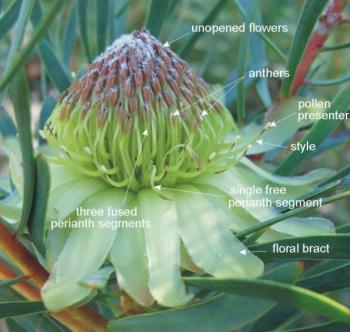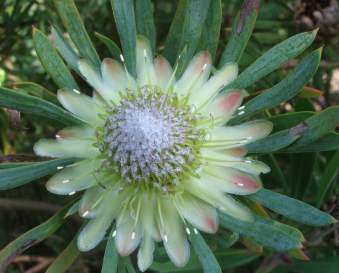Protea scolymocephala
Protea scolymocephala (L.) Reichard
Family: Proteaceae
Common names: thistle protea, thistle sugarbush, small green protea, scoly ( Eng. ); kleingroenroos, witskollie (Afr.)
Introduction
Protea scolymocephala is a dainty shrub bearing abundant pink-tinged, creamy-green flowerheads in winter/spring, ideal for small gardens on the sandy flats.

Description
Description
Protea scolymocephala is a small, neat, upright, well-branched shrub from a single main stem, 0.5-1.5 m tall. The leaves are long and narrow, shaped like an elongated, flattened spoon, 35-90 x 3-6 mm , hairless, with a pointed tip.

The buds are almost perfect globes, the floral bracts cover the young flowerheads like scales, on some bushes they are completely reddish pink, on most, creamy-green with a touch of reddish pink and on some they are completely creamy-green. The bracts open wide, starting out bowl-shaped and ending up flat or bending slightly backwards, with the tips bending up slightly, exposing the bunch of flowers in the centre. Each flowerhead opens to 35-45 mm across. The floral bracts are hairless, except for the margin that is fringed with hairs.
The exposed insides of the bracts are pale creamy-green and on some bushes the tips are flushed with reddish pink, whereas on others they are completely creamy-green. The flowers are bunched together in the centre, each flower consisting of four perianth segments-three fused and one free, and a style. In this protea, the perianth segments are 15-25 mm long, creamy-green or with pinkish brown tips, and hairless or with bristles on the tips. Together, they form a pinkish brown or silvery white, furry cap in the centre of a freshly opened flowerhead.

The style is 12-25 mm long, strongly curved inwards, with a 2 mm long white pollen presenter at its tip. The anthers are attached near the tip of the perianth segments, they release their pollen onto the pollen presenter before the flower opens. If you look inside the tip of the three fused perianth segments of a freshly opened flower, you can see the anthers. When the flower opens the perianth segments fall away exposing the style and pollen presenter. The outer ring of protea flowers open first.
Protea scolymocephala flowers in winter-summer (July-Nov.), peaking in spring (Aug./Sept).
When all the flowers have opened, the bracts close up again, enclosing the developing seeds. If you look into a bush you will see the previous years' flower heads as brown, woody balls on the previous season's growth. For harvesting purposes, the seeds should be left on the bush to ripen for about seven months. The seed is a small, dry, hairy nut. When the old flower heads are dead and dried, they open up again and the bracts curl back exposing the hairy seeds that fall out and blow away.

Conservation Status
Status
Vulnerable (VU). Protea scolymocephala faces a high risk of extinction in the wild. It was once abundant on the Cape Flats but it has lost its habitat to urbanization, agriculture and the spread of invasive alien plants like Acacia longifolia and A. saligna , and is now virtually extinct there. It is widespread and still common in the northern part of its range, but localized.
Distribution and habitat
Distribution description
Protea scolymocephala grows on sandy flats and coastal lowlands, often near drainage lines where there is a bit more moisture, from sea level to 400 m. It occurs from Gifberg and the Sandveld Flats to the Cape Peninsula and the Cape Flats with an outlying population near Hermanus, between Kleinmond and Hawston. It was once abundant, growing in large dense stands, and although still widespread and common in the Sandveld, it is almost extinct on the Cape Peninsula.
Derivation of name and historical aspects
History
The genus Protea was named in 1735 by Linnaeus after the Greek god Proteus who could change his form at will, because the proteas are so different in form. The species name scolymocephala means scolymus-head and refers to the similarity of the flowerheads to those of the genus Scolymus, thistle-like herbs in the family Asteraceae (daisy family) from the Mediterranean.
Protea scolymocephala attracted the attention of botanists visiting the Cape in the 1600s; it was described in 1700 by Plukenet and illustrated in 1705. It was introduced to English gardens in 1780, and being a neat, compact plant, was soon a popular glasshouse subject in Europe.
The Proteaceae is an ancient family. Its ancestors grew in Gondwanaland, 300 million years ago. The family is divided into two subfamilies: the Proteoideae, best represented in southern Africa, and the Grevilleoideae, concentrated in Australia and South America and the other smaller segments of Gondwanaland that are now part of eastern Asia. Africa shares only one genus with Madagascar , whereas South America and Australia share many common genera-this indicates that they broke away from Africa before they broke apart from each other.
In Africa, no species occurs further north than the Limpopo River, and 92% of the species occur only in the Cape Floristic Region, a narrow belt of mountainous coastal land from Clanwilliam to Grahamstown. The extraordinary richness and diversity of species characteristic of the Cape Flora is thought to be caused in part by the diverse landscape where populations can become isolated from each other and in time develop into separate species.
Ecology
Ecology
Protea scolymocephala is serotinous, i.e. it stores its seeds on the plant in the old flowerheads for years, and in the event of a fire, the bush is killed but the seeds survive and germinate en masse with the next rains. This fire-survival strategy works as long as the plants have sufficient time between fires to build up a new seed bank.
The hairs on the seeds aid in dispersal and germination: by expanding as the flowerhead dries, forcing them out of the head; once they are out, the hairs allow the seeds to be more easily moved by the wind; and once they land on the soil the hairs help to anchor the seed to the ground; and finally, the hairs help orientate the seed the right way round and channel water towards it.
When the flowers are still in bud, the anthers release their pollen onto the pollen presenter (a structure at the tip of the style). To avoid self-pollination, the stigmatic groove on the pollen presenter i.e. the surface on the stigma that is fertilized by pollen, stays closed and unreceptive until the pollen that was deposited by its own anthers has been removed from the pollen presenter. When the flower opens, the style and pollen presenter is exposed. Pollination occurs when the pollen from one flower is removed and then deposited on the pollen presenter of a different flower.
The pollinator of Protea scolymocephala is unknown.
Uses
Use
An unusual, long-lasting cutflower, smaller than most proteas and lovely in smaller arrangements and posies. Old, woody, dried flowerheads that have opened up again and dropped their seeds are decorative in dried arrangements.

Growing Protea scolymocephala
Grow
Protea scolymocephala is a rewarding and tough garden shrub, eye-catching when in flower and ideally suited to gardens on the sandy flats in and around Cape Town . It is an easy protea to grow, adapting to most soils but best in well-drained, acidic, sandy soils in full sun. It is quick-growing, flowering in its second year from seed and forming a dense, bushy, floriferous shrub about a metre in diameter within four years. When established it will tolerate drought, wind, and frost. Bushes are best replaced every 8-10 years.
Protea scolymocephala looks good as a single specimen or in small groups of 3-5 plants in the shrubbery or mixed border. If you have the space, allow them to grow in large dense groups like they used to on the Cape Flats . It is an excellent low-maintenance plant for a water-wise garden in the Western Cape , particularly if you live on the sandy flats.
Seed germinates freely and easily in 30-40 days. Sow in autumn in well-drained soil, cover lightly with clean sand or fine-milled bark and keep moist but not wet. Treating the seed with a fungicide increases the number of surviving seedlings. Transplant into individual containers as soon as the first pair of true leaves have developed. The first flowers can be expected in the second year. Seed can also be broadcast directly in the garden in autumn.
It can also be propagated by semi-hardwood cuttings taken from the current season's growth, in autumn or spring. Remove the leaves from the basal third of the cutting, treat with a rooting hormone, and place in a well-drained rooting medium under intermittent mist with a bottom heat of 25 °C.
References
- Protea Atlas Project, http://protea.worldonline.co.za
- Rebelo, A. (Tony). 2001. Proteas. A field guide to the proteas of southern Africa, edn 2. Fernwood Press, Cape Town.
- Rourke, J.P. 1982. The proteas of southern Africa . Centaur Publishers, Johannesburg .
- Vogts, M. 1982. South Africa's Proteaceae, know them and grow them. Struik, Cape Town.
Credits
Alice Notten
Kirstenbosch National Botanical Garden
August 2006
Plant Attributes:
Plant Type: Shrub
SA Distribution: Western Cape
Soil type: Sandy
Flowering season: Spring, Early Summer, Winter
PH: Acid
Flower colour: Green, Pink, Cream
Aspect: Full Sun
Gardening skill: Average
Special Features:
Horticultural zones











Rate this article
Article well written and informative
Rate this plant
Is this an interesting plant?
Login to add your Comment
Back to topNot registered yet? Click here to register.